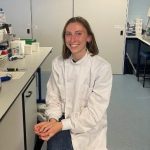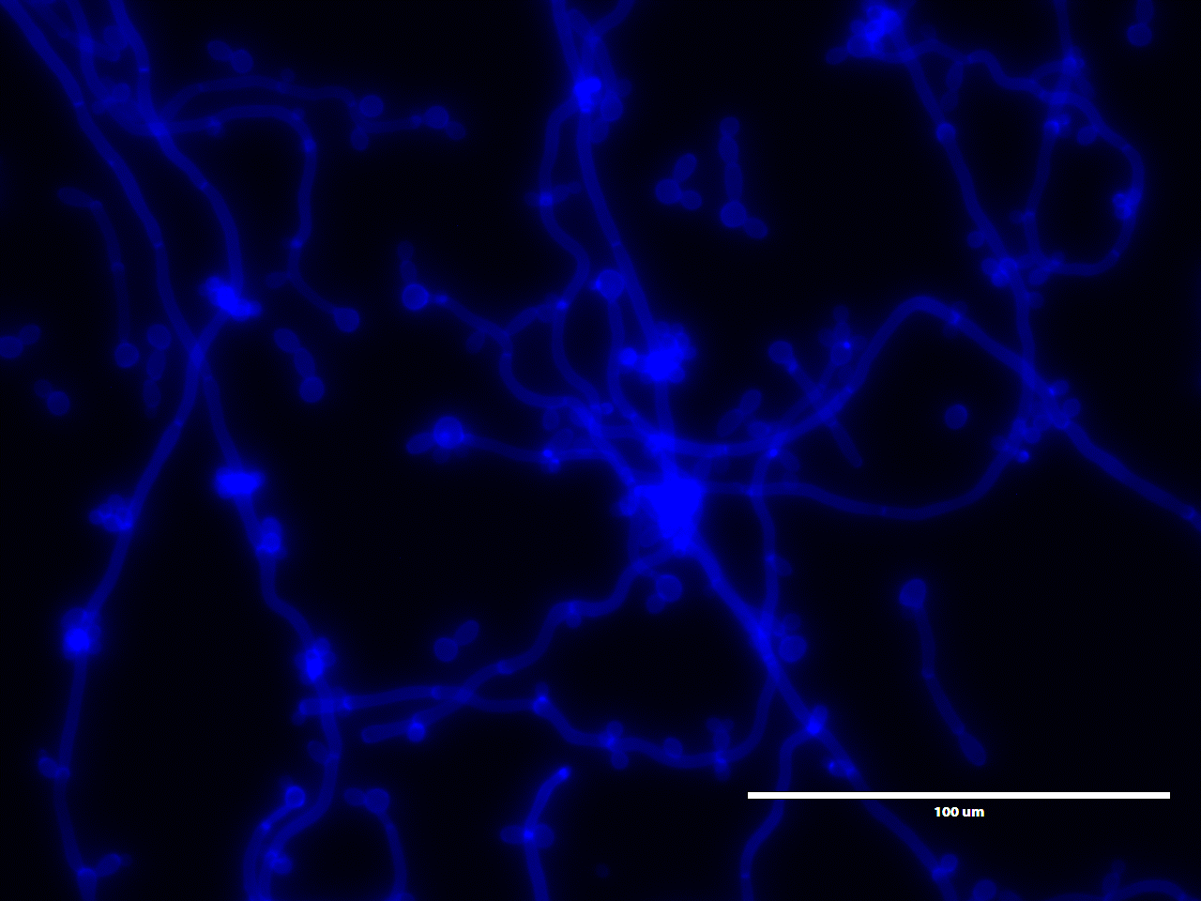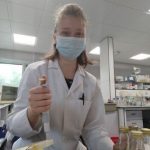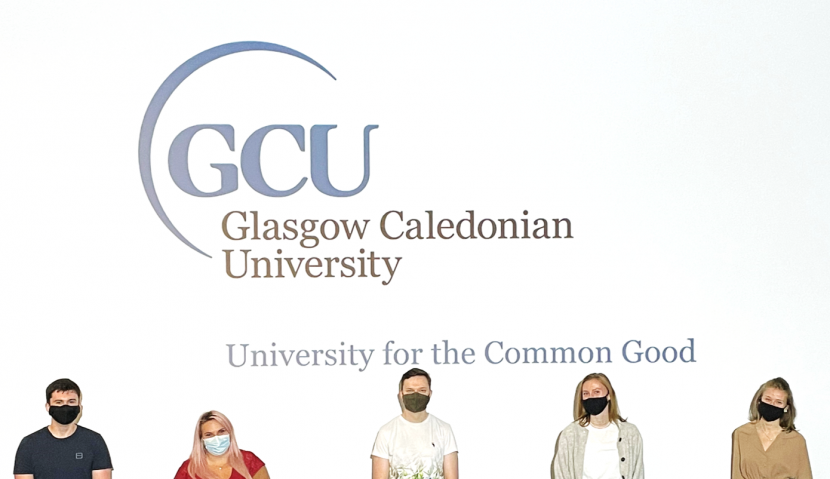It was a very busy summer in our GCU microbiology and food labs this year with three undergraduate students being awarded funded summer studentships. These students joined up with Ph.D. and other postgraduate students and undertook 8-week research placements. These placements were very successful and a massive thank you to the British Mycological Society, Microbiology Society, Society for Applied Microbiology for generously funding these opportunities.
You can find out what the students got up to below:
Willemijn Kuiters
British Mycological Society

‘The effect of polymicrobial interactions on Candida biofilm heterogeneity’
Tell us a bit about your project?
For my studentship I investigated the effect of polymicrobial interactions on the heterogeneity of Candida albicans biofilms. It is well known that C. albicans and Staphylococcus aureus can attach and interact physically, therefore the aim of this project was to explore their chemical relationship and assess if molecule(s) secreted by S. aureus could induce biofilm formation of C. albicans.
What techniques did you use?
To test our hypothesis, we used a number of techniques which focussed around assessing biofilm production of C. albicans in the presence of S. aureus biofilm supernatant. We quantified the biofilm biomass using staining and metabolic assays and used fluorescent microscopy to detect any changes in morphology of the cells. We also used qPCR to look at changes in expression of three genes of interest: HWP1, ALS3 and ZAP1.
What did your results show?
The results from the biomass assays demonstrated that there was an increase in overall biomass but not in cell viability or cell numbers. This was further highlighted based on the fluorescent microscopy images. This, together with an increase in expression of the ZAP1 gene from the qPCR results would indicate an increase in extracellular matrix of the biofilms, which is a protective layer of the biofilm which shields it from drugs and stressors.
How has the studentship benefited your own development?
I am very grateful to have had this experience as I have really enjoyed my time in the lab. I was able to strengthen and learn many skills as preparation for my final year in university as well as for after graduation. I have very much enjoyed talking and working with my colleagues as they were a key part of my experience. This studentship has confirmed for me that my future after university is in research.
Michal Kras
Microbiology Society

‘Development of an in vivo model to study Candida biofilms’
Tell us a bit about your project?
Hello! My name is Michal Kras, I am a 4th year Biomedical Science student at Glasgow Caledonian University. I was fortunate to qualify for the Harry Smith Vacation Studentship award to work on a project titled Development of an in vivo model to study Candida biofilms. Over eight weeks, I investigated biofilm formation of Candida albicans and Staphylococcus aureus in single cultures and co-cultures, and their in vivo virulence using Galleria mellonella larvae as model organism to study biofilm formation.
What techniques did you use?
To mimic biofilm formation using the G. mellonella model, biofilms were grown overnight on toothbrush bristles which acted as the substrate for biofilms to grow. After these were grown, we originally quantified how many cells were present within the biofilms using traditional counting techniques. Also, this experiment was repeated with an additional step of incubation with various concentrations of different antimicrobial compounds to assess any additional antimicrobial tolerance of biofilms compared to free floating (planktonic) cells. Based on this data, these numbers of cells were then used in in vivo experiments, comparing mortality between G. mellonella larvae inoculated with biofilm-covered toothbrush bristles and planktonic infections. Finally, qPCR of biofilm and planktonic cultures of C. albicans was performed, looking at expression levels of three key biofilm regulatory genes.
What did your results show?
Both organisms grew at different rates in a co-culture biofilm while compared to single organism biofilms – C. albicans grew less while S. aureus grew more. Biofilm cultures also tolerated higher concentrations of antimicrobials than planktonic cells and both of these findings are well known mechanisms supported with previous evidence from the literature. When mortality of biofilms and planktonic cells were assessed using G. mellonella, it was shown that biofilms were slightly more virulent, but more experiments would need performed to confirm these findings. From the qPCR data, two of the three genes of interest, ALS3 – a cell wall adhesin and HWP1 – hyphal cell wall protein, were markedly upregulated in biofilm cultures compared to planktonic cells.
How has the studentship benefited your own development?
Firstly, I want to say I loved it, it was the highlight of my summer! The project reaffirmed my enjoyment of practical lab work and interest in medical microbiology and I’m excited to continue working with fungal biofilms during my Honours project. My confidence in my lab skills increased and I realized how much I can still improve. Opportunity to work in the same space as PhD students allowed for discussion about different professional pathways I could consider. Finally, I improved my data analysis skills and learned to use new statistical analysis software which will be useful in my Honours year.

Loredana Herciu
Dr Ryan Kean and Dr John Butcher
Society for Applied Microbiology

‘Analysis of antimicrobial resistance genes in food’
Tell us a bit about your project?
Antimicrobial resistance (AMR) is a global issue which will continue to escalate in years to come unless more action is taken. This is not only related to humans, with animals and food also providing ways in which antimicrobial resistant organisms can spread. My project was investigating the potential of AMR spread using food with the aim to identify the presence of any AMR genes in unknown samples of bacteria, cultured from different partially frozen breaded chicken samples.
What techniques did you use?
I used multiple techniques throughout my placement and these included identifying and culturing bacteria using conventional and selective agars and broth media. Following culturing, I then used DNA extraction and Polymerase Chain Reaction (PCR) to identify if Escherichia coli were present within these samples. I then used Antibiotic mastrings and broth dilution techniques to assess the susceptibility of identified bacteria to various antimicrobials before finally using PCR to detect the presence of any AMR genes within the foodstuff.
What did your results show?
Bacteria were present in all analysed foodstuffs, with no Salmonella species recovered. From the results obtained, it has been possible to identify four strains of E. coli using species specific qPCR. Of these identified E. coli, these were shown to express several beta-lactamase genes including AmpC and CTX-M which can cause resistance to beta lactam antibiotics. Furthermore, when tested for their antimicrobial sensitivity, three of these strains showed resistance to ampicillin and nalidixic acid.
How has the studentship benefited your own development?
My self-confidence in laboratory settings has greatly improved, alongside with my planning, data recording, multitasking and organisational skills. It strengthened my adaptability and communicational skills while also providing me the right basis for my final year Honours project. I highly recommend a summer studentship to further students to apply for similar experiences. It was amazing!

To find out more about the SHIP team, head on to the GCU website, read the rest of our blogs and follow us on Twitter @SHIPGCU
